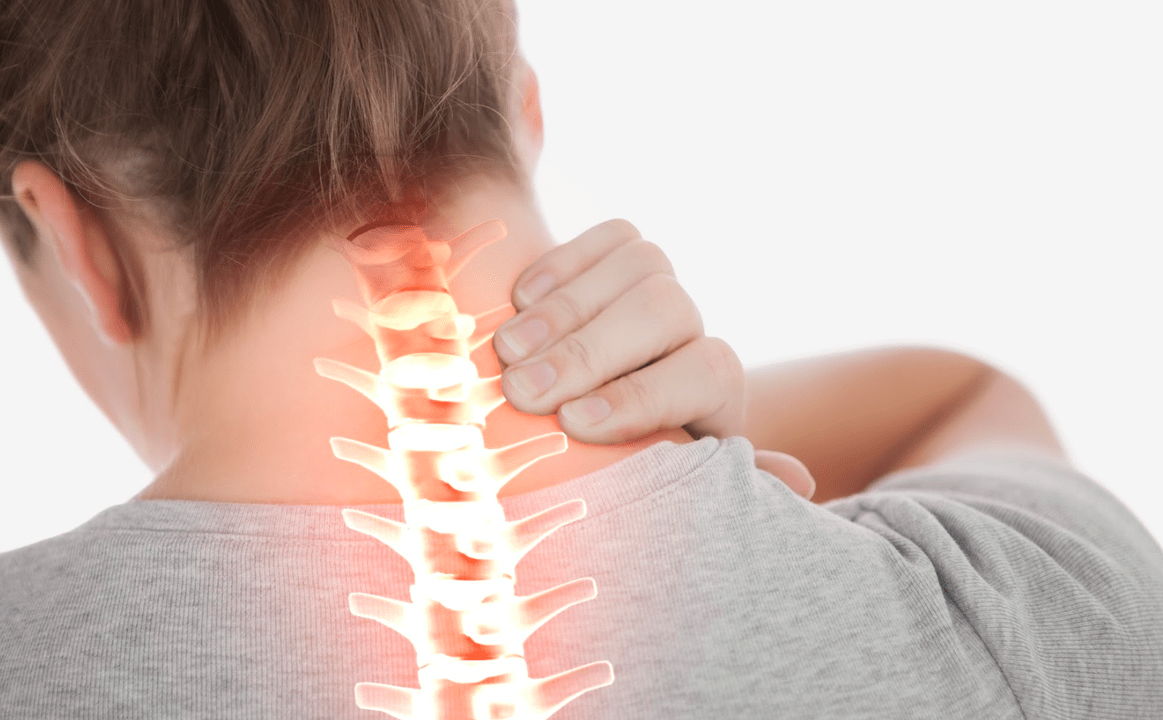Osteochondrosis is a degenerative wound that damages the spine, including defeat of the vertebral corpse, articular device, ligaments and intervertebral discs. The disease is quite common in all countries - from 45 to 85% of the population experienced the disease. The onset of osteochondrosis occurs in patients over the age of 30-35, however, the early cases of the disease are known. Men and women are sick at the same frequency.
Cause

There is no cause of united osteochondrosis development. There are a large number of predisposing causal factors. The main one is as follows:
- Spinal injury (fractures, bruises, dislocation);
- Descent tendency;
- Foot disease that causes the advantage of the spinal cord - these include flat feet, varied foot deformation, deformation of foot valgus;
- Wearing close and uncomfortable shoes for a long time (also causing spinal load);
- Overweight and obesity;
- Age -related changes;
- SEDENTARI LIFE;
- Athletes who arrived -left their training and classes;
- Metabolic disorders;
- Spinal curvature (kyphosis, lordosis, scoliosis);
- Professional features - lifting weight, frequent turns and body screams, working in uncomfortable body position;
- Frequent and prolonged hypothermia;
- Pressure;
- Certain climate, both at home and at work - low air temperatures and high humidity.
When exposed to one or more causal factors, the development of the disease begins. It is customary to divide it into four main stages:
- First stage. There is a decrease in the amount of moisture in the intervertebral disc core, it becomes evenly flat, the distance between the vertebrae decreases. The cartilage is covered with small cracks.
- The second stage. Due to the reduction in the distance between the vertebrae, the muscle and ligaments of the vertebra occur. This leads to the pathology mobility of the body -vertebrae, to their displacement.
- The third stage. Due to the progressive process of the spinal cord, the intervertebral disc protrusion (protrusion) of the vertebral subluxation occurs.
- The fourth stage. Between vertebrae, bone spikes (osteophytes) appear, aimed at eliminating vertebral movement, prevention of dislocation. Over time, there are many of those who are completely affected by the loss of their mobility. In this case, there is trauma to blood vessels and nerves that pass the vertebra and leave the spinal column.
In the first and final stages of clinical manifestation (pain), patients do not have.
Classification
There are many classifications of osteochondrosis. Each doctor chooses the most acceptable to himself. The following classifications are most commonly used:
Classification of spinal defeat:
- Cervical osteochondrosis;
- Thoracic osteochondrosis;
- Lumbar osteochondrosis;
- Osteochondrosis;
- Extensive osteochondrosis (common) - affects 2 or more spine.
Classification with the level of change in the intervertebral disc (radiological stage):
- 0 level - no disc changes;
- Stage 1 - small changes, including maximum internal tears;
- 2 stages - severe changes in the disc while maintaining the outer surface;
- Stage 3-entire disc is fully affected (cracked by spreading to the outer surface, squeezing the disc from under the body of the vertebra, etc. ).
Classification by clinical manifestations and the level of defective spinal function:
- The first stage - the function of the spinal cord does not change, the patient feels a bit of pain in the wound;
- 2 stages - disturbed spinal function (subluxus of vertebral body occurs, disc promotion, nervous pinching), pain in the site of destruction is increasing;
- Stage 3 - defective spine, intervertebral disc hernia occurs, significant pain;
- Level 4 - Patients are difficult to move, spinal movement decreases, pain during slight movement. Patients are defective.
Symptoms of osteochondrosis

Symptoms of osteochondrosis depend on the area of damage to the spinal cord and at the level of disruption.
For the clinical picture of cervical spinal osteochondrosis, the following marks are characteristic:
- Visual sharpness violations;
- Dizzy;
- Tinnitus;
- Blinking "flies" in front of the eyes and the appearance of colored spots;
- Hearing loss;
- Headaches in the nape, temporal and parietal areas, increasing when moving the cervical spine;
- Loss of consciousness;
- Snoring;
- Hoarse voice or weakness;
- Numbness and loss of sensitivity to the skin, neck and hands;
- Dental destruction;
- Blood Pressure Board.
For thoracic spinal osteochondrosis, the following symptoms are characteristic:
- Pain in the liver, lasting, pain or pressing, often sharp, stitching, sharp, the patient may show certain points of pain;
- Skin numbness in the chest, stomach and back;
- Spinal pain, especially between shoulder blades, is highly stated;
- Pain when lifting hands;
- Pain with a sharp and deep breath, and then join when exhale;
- Pain, discomfort and difficulties during the body's tilt to any direction.
The following symptoms are characteristic of lumbar and sacred spinal osteochondrosis:
- Pain in the lumbar and sacred spine (lumbalgia), which can give in one or both legs, intensively with spinal movement in the affected area;
- Feet freeze at comfortable temperatures for other parts of the body;
- Tension is almost continuous in the back muscles, especially the lumbar region;
- Feelings of numbness, crawl goosebumps and tingling on the skin and buttocks;
- Varicose veins in the feet;
- Potential violations in men;
- Increased sweating;
- Pale skin on the feet;
- Irregular menstruation in women.
With prolonged and neglected osteochondrosis, when the fuse of the vertebrae affected by each other, the patient is only concerned with the loss of movement in the spine, pain, as a rule, decreases or leaves completely.
Diagnostics
First of all, the doctor conducted a patient's review and examination, establishing an early diagnosis. For verification, additional exam methods are provided. With osteochondrosis, they only play a role, as the lab (test) will not show any confirmation changes.
The main diagnostic method includes the following:
- Exam X -Ray. Allows you to determine the degree of damage to the vertebra, their location, bone formation. With indirect methods, you can determine the condition of the bone tract and the intervertebral disc;
- Calculated tomography (CT). Allows you to determine the state of the intervertebral disc, its structure and its shape, the deformation of the vertebra and the compression of the nerve and root ends;
- Magnetic resonance imaging (MRI). Allows you to determine smaller violations in the spine and are set in cases where controversial issues remain CT positions;
- Ultrasound procedure. Allows you to identify the level of blood flow in vessels that feed spinal cord and other organs;
- Myelography. Radiographic methods of spinal cord use contrast material. Allows you to identify intervertebral hernia.
Osteochondrosis treatment
Conservative treatment
In the treatment of osteochondrosis, conservative treatment methods are used primarily. In this case, the approach to each patient should be individual and complex. Conservative treatment methods can be divided into 4 main groups:
- Drug treatment;
- Physiotherapy;
- Spa treatment;
- Diet (the basis of proper nutrition).
Treatment of osteochondrosis drug

The drugs used in the treatment of osteochondrosis must be used during the enlargement period. They contribute to the decline in symptoms, and also affect several causal factors in the development of the disease. The main group of drugs used in the treatment of osteochondrosis:
- NSAID. Nonsteroidal anti -anti -anti -anti -anti -anti -anti -inflammatory effects, and also reduce the high temperature of the affected tissue from the spine and its structure. With the symptoms mentioned, the first days that worsen the disease is prescribed in the form of injections. The frequency of use is 1-2 times a day. After that, they turn to the form of a drug tablet with a 10-30 day treatment rate, if necessary. The frequency of admission is from 1 to 4 times a day. Also, along with tablets and injections, ointments or creams are shown, which is used on the skin in the spine area 1-3 times a day.
- Musorelaxants. The preparation of this group is to overcome increased muscle tone, relaxing horizontal muscle fibers and facilitating the patient's condition. Flat -Rata, treatment is about 1 month. With severe symptoms, treatment begins with the form of drug injection. The dose must start with a minimum, gradually increasing until the therapeutic effect is achieved, after which gradually decreases to complete the cancellation.
Several groups are used as additional drugs:
- Vitamins. Accelerate tissue recovery process, normalize nerve conductivity, accelerate metabolism, and more. Almost always these drugs for osteochondrosis are prescribed in the form of injections, for 10 days. This is vitamins B1, B2, B6, E.
- Blood preparations. These drugs normalize blood flow to the veins and arteries, restore muscle tone of the blood vessels, and restore metabolism. Often, a tablet release form is used. The duration of treatment with this agent is from 1 to 3 months. Also, in extreme cases, the injection of the drug is possible for the first 5-10 days, with the next transition to the tablet.
- Glucocorticosteroids. They have anti -inflammatory effects, decongestants, improve NSAID work and muscle relaxants. Depending on the severity of the patient's condition, they are prescribed in the form of intramuscular or intra -fast injection, or in the form of tablets for oral administration. The course of treatment is selected individually, from a few days to several weeks. The removal of the drug should occur with a gradual decrease in dosage.
- Biogenic stimulants. Accelerate metabolism, stimulate tissue recovery, reduce inflammation and swelling of tissues and more. It is usually used in the form of injections and is less common in the form of tablets or other forms for oral administration. The course of treatment can range from 1 week to 2-3 months, depending on the severity of the disease.
Osteochondrosis Physiotherapy Treatment
Steps -Physiotherapy steps, combined with medicines, allow you to speed up the recovery process, and also extend the remission period when used beyond severity. There are many physiotherapy methods and are mostly well practiced in the treatment of osteochondrosis:
- Electrophoresis. Depending on the drug used in this procedure, the effect of analgesic is obtained. Metabolism improves and normalization of blood flow in the affected tissue.
- Acupuncture (acupuncture). With the help of the best needle and its effect on the active point located on the patient's skin, analgesic effects are achieved, the recovery and metabolic processes are stimulated, and inflammation decreases.
- Magnetotherapy. Reduces pain, swelling and inflammation of the tissue, accelerates the nerve conductivity, normalizing the metabolic process
- Manual therapy. Mobility is restored to the spinal joint, the pain syndrome is reduced.
- Massage. Normalizing muscle tone, eliminating back pain, restoring nerve conductivity.
- Exercise therapy. Restores spinal mobility, decrease in pain, normal lifestyle recovery, strengthening back muscle frame, back muscle relaxation, acceleration of metabolism.
- Spinal attraction. Spinal mobility is restored, preventing the development of the disease and the development of complications, and anesthetics.
- Laser therapy. Increases blood supply, stimulates tissue regeneration, reduces pain and inflammation, reduces spinal swelling.
- Thermotherapy. Anesthetic effects, normalization of blood flow and lymph through the blood vessels, decreased inflammation in the tissue, the acceleration of cartilage recovery.
- Mudreing (peloid therapy). Reduces pain in the spine, reduces muscle cramps, slightly reduces the process of inflammation, increases blood supply and metabolism.
One patient can be prescribed for 1 physiotherapy and complex events. It depends on the severity of the osteochondrosis process and on the accompanying pathology. The average treatment period is 10-15 days. It is recommended to repeat 3-4 times throughout the year. Therefore, it is possible to reduce the frequency of severity and development of osteochondrosis several times.























